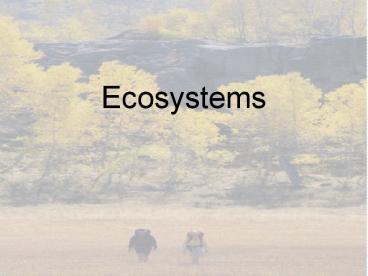Ecosystems - PowerPoint PPT Presentation
1 / 13
Title:
Ecosystems
Description:
Ecosystems. Photosynthesis. Plants take in energy from the sun. ... In most ecosystems, plants of the main population are where organisms interact. ... – PowerPoint PPT presentation
Number of Views:795
Avg rating:3.0/5.0
Title: Ecosystems
1
Ecosystems
2
Photosynthesis
Plants take in energy from the sun.
Leaves take in carbon dioxide and give off oxygen
as a by-product.
Plants make glucose to use as food. Food that is
stored is called starch.
Roots take in water and nutrients from the soil.
3
Systems
- System a group of parts that work together as a
unit. - A system has cycles and processes that interact,
or affect each other. - Open systems let things out. Thinks coming into
a system are inputs. - Closed systems have no inputs and no outputs.
- Over time a system will reach stability changes
in the system cancel each other out.
4
Parts of an Ecosystem
- Groups of living things and the environment they
live in make up an ecosystem. - A group of the same species living in the same
place at the same time is a population. - Several populations of different kinds can exist
in one ecosystem. - A swamp is an area that is sometimes covered in
shallow water.
5
Parts of an Ecosystem
- In most ecosystems, plants of the main population
are where organisms interact. - A community is made up of all the populations
that live in the same area. - Nonliving parts of an ecosystem interact with one
another and with living things. - Nonliving things are sunlight, soil, air, water,
and temperature.
6
Living Things in an Ecosystem
- Habitat an environment that meets the needs of
an organism - Niche role
- Producers Make their own food (plants and
algae) - Consumer Eat other living things (herbivores,
carnivores, and omnivores) - Decomposers feed on the wastes of plants and
animals or on their remains after they die,
returning nutrients to the soil.
7
Energy Pyramid
- A diagram called an energy pyramid shows how much
food energy is passed form one organism to
another along a food chain.
8
Food Web
9
Changes in the Ecosystem
- Over time, changes in climate, rate of erosion,
and populations can cause big changes in an
ecosystem. - Some changes, such as storms or changes caused by
people, can change an ecosystem quickly.
10
Changes in the Ecosystem
- Succession the process by which one community
is replaced by another until a stable community
occupied the area. - A forest fire is an example of succession.
11
Changes in the Ecosystem
- Lichens and mosses will establish themselves in
an ecosystem quickly. - As plant and animal matter decomposes over time,
nutrients are added back into the soil. - Producer makes food
- Consumer eats other plants and animals
- Decomposer breaks down decaying plant and
animal matter.
12
Repairing the Ecosystem
- Reclamation repairing some of the damage to an
ecosystem. - Many times people can help repair and improve
ecosystems.
13
Preserving the Ecosystem
- Conservation careful management and wise use of
natural resources. - Reduce use less
- Reuse use it again
- Recycle make the old into new
- Redesign change a product to use fewer
resources to make it. - Preservation protection of an area































